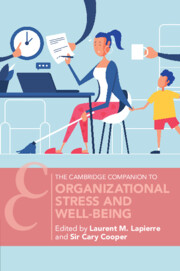Book contents
- Organizational Stress and Well-Being
- Cambridge Companions To Management
- Organizational Stress and Well-Being
- Copyright page
- Contents
- Figures
- Tables
- Contributors
- Introduction
- Part I Historical Evolution and Continued Relevance of the Study of Organizational Stress and Well-Being
- Part II Line Managers
- Part III Major Issues Relating to Stress and Well-Being
- 6 Work–Nonwork Balance and Employee Well-Being
- 7 Understanding the Decision-Making Process for Presenteeism Behavior
- 8 Burnout
- 9 Work Engagement and Organizational Well-Being
- 10 How and Why Gender Relates to Workplace Stress and Well-Being
- 11 The Measurement of Well-Being at Work
- Part IV Workplace Interventions Addressing Stress and Well-Being
- Part V Emerging Issues
- Subject Index
- References
10 - How and Why Gender Relates to Workplace Stress and Well-Being
from Part III - Major Issues Relating to Stress and Well-Being
Published online by Cambridge University Press: 23 February 2023
- Organizational Stress and Well-Being
- Cambridge Companions To Management
- Organizational Stress and Well-Being
- Copyright page
- Contents
- Figures
- Tables
- Contributors
- Introduction
- Part I Historical Evolution and Continued Relevance of the Study of Organizational Stress and Well-Being
- Part II Line Managers
- Part III Major Issues Relating to Stress and Well-Being
- 6 Work–Nonwork Balance and Employee Well-Being
- 7 Understanding the Decision-Making Process for Presenteeism Behavior
- 8 Burnout
- 9 Work Engagement and Organizational Well-Being
- 10 How and Why Gender Relates to Workplace Stress and Well-Being
- 11 The Measurement of Well-Being at Work
- Part IV Workplace Interventions Addressing Stress and Well-Being
- Part V Emerging Issues
- Subject Index
- References
Summary
There are three primary theoretical perspectives detailing why gender differences in workplace stressors may exist: the differential exposure perspective, the psychological/coping perspective, and the biological sex differences perspective. The purpose of this chapter is to discuss how and at what point gender is proposed to influence the stressor–well-being process in addition to summarizing empirical evidence regarding gender differences in the mean levels of common work stressors: work–family conflict, job demands, job autonomy/decision latitude, work hours, and career concerns. Gaps in the present literature are identified and recommendations for future research are provided.
- Type
- Chapter
- Information
- Organizational Stress and Well-Being , pp. 309 - 346Publisher: Cambridge University PressPrint publication year: 2023

